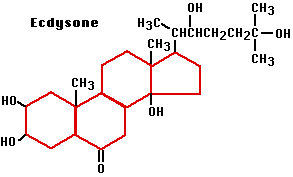| Index to this page |

Because of their rigid exoskeleton, insects can only grow by periodically shedding their exoskeleton — called molting.
Molting occurs repeatedly during larval development. At the final molt, the adult emerges.
In several insect orders, notablyComplete metamorphosis takes place during a seemingly-dormant stage called the pupa.
But, in fact, intense biological activity is going on within the pupal case. The cells of virtually all the differentiated larval structures — muscles, salivary glands, gut, etc. — die by apoptosis. The nutrients they release are then available for the further development of nests of cells — the imaginal discs — that have been quietly developing within the larval body. Their differentiation produces the structures of the adult — legs, wings, compound eyes, etc.
The sequence ending in the center panel (B) shows the larval, pupal, and adult stages during normal development of the domestic silkworm moth, Bombyx mori.
Molting and pupation require the hormone, PTTH, secreted by a two pairs of cells in the brain of the larva. If these cells are cut out of the brain of a full-grown larva, pupation does not occur. This is not because of the trauma of surgery; if transplanted somewhere else in the caterpillar's body, pupation occurs normally.
PTTH is a homodimer of two polypeptides of 109 amino acids.PTTH does not drive pupation directly but, as its name suggests, acts on the prothoracic glands.

There are two prothoracic glands located in the thorax. Under the influence of PTTH, they secrete the steroid hormone ecdysone.
Acting together, PTTH and ecdysone trigger every molt: larva-to-larva as well as pupa-to-adult. What, then, accounts for the dramatic changes of metamorphosis?
 Juvenile hormone is secreted by two tiny glands behind the brain, the corpora allata.
Juvenile hormone is secreted by two tiny glands behind the brain, the corpora allata.
| Link to the molecular structure of a JH. |
As long as there is enough JH, ecdysone promotes larva-to-larva molts. With lower amounts of JH, ecdysone promotes pupation. Complete absence of JH results in formation of the adult.
So if the corpora allata are removed from an immature silkworm, it immediately spins a cocoon and becomes a small pupa. A miniature adult eventually emerges (shown in panel (A) above).
Conversely, if the corpora allata of a young silkworm are place in the body of a fully-mature larva, metamorphosis does not occur. The next molt produces an extra-large caterpillar (panel (C) above).
Adult insects do not normally molt, but if extra amounts of PTTH are given to an adult Rhodnius (the "kissing bug"), it is forced into an extra molt. The English insect physiologist V. B. Wigglesworth showed that if juvenile hormone is first applied to the insect's exoskeleton, the regions affected by it revert to larval type after this extra molt.

These images (courtesy of Dr. Wigglesworth) show his results.
What a beautiful example of the power of a single molecule to unleash a different pattern of gene expression! Presumably, JH interacts with hormone receptors in the cells to produce a new set of transcription factors.

The swallowtail butterfly, Papilio xuthus, passes through 5 larval stages ("instars") growing larger after each molt. The first four larval stages resemble bird droppings looking like brown fecal matter with a whitish paste of uric acid (which is the nitrogenous waste of birds). The photograph shows the 3rd (left), 4th (middle), and 5th (right) instars. See how after the fourth molt, the 5th instar has quite a different appearance — being well camouflaged as it feeds on its host plant (right).
R. Futahashi and H. Fujiwara reported in the 22 February 2008 of Science that the dramatic transition from the 4th to the 5th instar is accompanied by a drop in the level of JH. When they applied synthetic JH soon after the molt from the 3rd to the 4th instar, when the final molt occurred, the 5th instar continued to resemble a bird dropping.
They also found that treatment with synthetic JH altered the expression of several genes associated with the transition from the bird-dropping phenotype to the camouflaged phenotype.
(Photo courtesy of Dr. Fujiwara.)
Knowledge of insect hormones has provided a number of opportunities to enlist them — or molecules related to them — in the battle against insect pests. Link to a discussion.
| Welcome&Next Search |